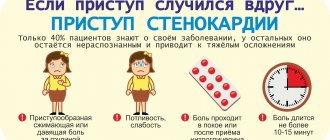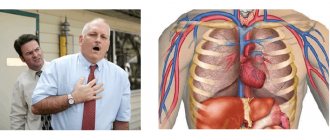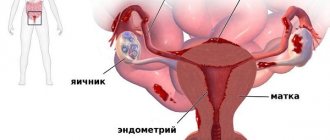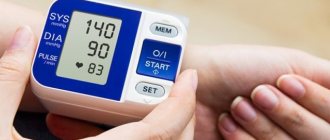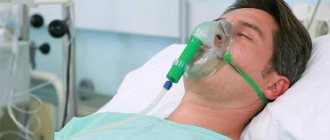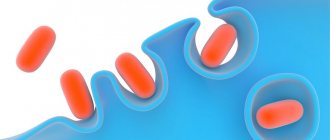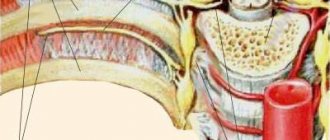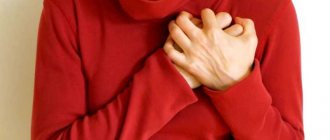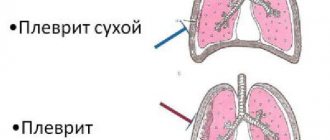Upon reaching the age of 30-35 years, a person is often bothered by unpleasant pain in the area of the heart, which appears seemingly for no reason. Pain can occur with deep breaths, active movements, be constant or periodic, sharp and dull, radiate to the arm, cause difficulty breathing. It is important to understand what caused the pain syndrome and take the necessary measures, more on this in the article below.
Since childhood, we are taught to be very attentive to any manifestations of discomfort that arise in this area, so the symptom that appears is very frightening. In fact, there are quite a few causes of pain in this area.
In addition to the heart muscle, which is the first thing you think about, there are manifestations of spinal curvature, intercostal neuralgia, as well as the stomach, spleen and other abdominal organs. If we are talking specifically about the heart, then most likely there is coronary disease, hypertension and others.
Where is the heart actually located?
The heart muscle is considered a vital organ, with a volume approximately equal to a human fist. Its placement in the chest is slightly different from traditional ideas. The right edge is located approximately along the axis of the spine, the left border in men (in women, due to the difference in the shape and size of the breast, this landmark cannot be used) to the right of the left nipple, in height it begins approximately below the level of the collarbone in the area of the spine, in shape, expanding downward, and ends approximately between the 5th-6th rib.
Thus, one must understand that the placement of the heart is not radically left-sided, but simply to the left of the spinal axis.
How to understand whether your heart hurts or not?
After the appearance of pain in the chest, the first thing you should do is figure out and understand what its cause is, whether it is cardiological or non-cardiological.
When the heart or its vessels are susceptible to disease, pain on the left side is called cardiac and the following symptoms are distinguished:
- Location: behind the sternum, to the left border of the clavicle
- The type of pain is very different: aching, pressing, stabbing, dull
- No pain between the ribs or in the spine area
- Pain of cardiac origin is not associated with light physical activity, such as raising and lowering the arms, but occurs after physical activity
- Angina occurs as a result of eating a large amount of food and, for example, active walking after that. It is important to note that there will be no heartburn, belching or bowel irregularities.
- It often radiates to the left hand, the lower jaw on the left, is localized in the left shoulder blade, but there are no sensory disturbances, the left hand does not feel cold, there is no weakness, the skin color is normal.
Non-cardiological nature of the pain that occurs
Non-cardiac means that the pain is not caused by the heart. If the intensity of pain on the left side varies with bending, turning the body, deep breathing, swinging and rotating the arms, and nitroglycerin does not have a neutralizing effect, then most likely the source will be intercostal neuralgia or radiculitis of the chest.
Neurosis is possible, the nature of the pain in it is aching or stabbing, it is concentrated locally and manifests itself briefly or periodically.
It has been proven that even ordinary stress and depression can cause physical pain in the left chest, so the classic scene when a woman clutches her heart after hearing something that shocked her is not a work of fiction.
The stabbing and squeezing nature of the pain is often caused by problems with the intestines, bloating, which disrupts the normal functioning of the heart muscle. If, when eating a certain type of food, you experience pain in the left breast, then perhaps the problem is the malfunction of the pancreas or the stomach itself. In addition to those indicated, a likely source may be a weak thoracic region, spinal curvature or osteochondrosis.
With neuralgia of the intercostal nerves (intercostal neuralgia), pain, which can be both chronic and acute, appears due to compression of the intercostal nerves. This type of pain is usually accompanied by burning, tingling or numbness in the rib area, including the left side. A characteristic feature is the lack of improvement effect if you take nitroglycerin. Intercostal neuralgia often appears with age; it can be caused by diseases of the spinal column, diabetes mellitus, and pathologies of the stomach and intestines.
There is no treatment for intercostal neuralgia as such. Usually the doctor’s task is to relieve pain on the left side and improve the condition of the intercostal nerves, preventing recurrence of the disease. To do this, they prescribe medications that relieve spasms, conduct a course of physiotherapy, and sometimes acupuncture.
With osteochondrosis of the thoracic region, the cartilage tissue of the joints wears out, which leads to pain during movement or stress.
Treatment options
Only a specialist can prescribe therapeutic measures, taking into account the type of disease and how severe it is. Self-prescribing any treatment for arrhythmia is extremely dangerous; the consequences can be fatal.
Therapeutic measures are based on measures aimed at reducing the symptoms of the disease, increasing survival in certain periods, eliminating the consequences and possible complications. Treatment can include both medications and surgery.
Medicines for the treatment of arrhythmia are divided into three types: drugs that cope with the atrial type of disease, aimed at treating ventricular disorders, and a universal group that affects both types of disease.
A procedure called radiofrequency ablation helps restore normal heart rhythm and completely relieve the patient from the disease. To carry it out, a special catheter is used, which is used to cauterize a specially defined small cardiac area. In the future, it will act as a blockade for the impulse.
Finding the Causes of Pain
After pain appears on the left side of the chest, the first thing you should do is consult a cardiologist to find out whether the pain syndrome is cardiological in nature.
The most accessible method for quickly diagnosing the functioning of the heart muscle and identifying pathologies in it is an ECG or electrocardiogram. The essence of the study is to attach sensors to the body, which, capturing the rhythm of the blood beat, produce a graph.
Using this chart, the cardiologist determines the presence of abnormalities in certain parts of the heart. A traditional ECG consists of obtaining a cardiogram in a quiet mode for just a few seconds. Often such a study is not enough to identify pathologies, then an ECG is performed “under load”, or Holter monitoring, when sensors and a receiver, powered by a battery, are attached to the patient’s body and readings are taken throughout the day. Due to this, the doctor sees a complete picture of the behavior of the heart muscle during all periods of wakefulness and sleep. Phonocardia is used to check for the presence of a heart murmur.
The general condition of the organ, as well as the functioning of the valves and the flow of blood in various parts of the heart, is checked using a procedure called echocardiography.
To assess the condition of the coronary arteries, a coronography procedure is performed, and deficiencies in the blood supply are checked using myocardial scintigraphy.
To verify the “non-cardiac” origin of pain on the left side, chest examinations are used using X-rays, computed tomography and MRI of the spinal region; for this you need to contact a neurologist or orthopedist; for more in-depth examinations, you need to visit a gastroenterologist.
When examining a patient, a cardiologist pays attention to how the patient talks about the symptoms.
The following relationship is used for assessment: if the patient speaks very vividly, in detail and openly about his painful sensations, without skimping on details, then, most likely, this indicates that the heart is not the source of pain.
An additional factor in favor of this conclusion is the detail that the pain is accompanied by a rapid heartbeat. And vice versa, a meager and dry narrative about the presence of pain with precise details, rather talk about “heart” reasons.
Stitching under the left rib - what is it connected with?
Pain in the left side can be a symptom of a rather serious illness. It is because of this that doctors recommend immediately responding to such a signal from your body, since delay can cause serious and sometimes tragic consequences. In this case, by the way, the golden rule of a physician is “It is easier to treat any disease at the first stage of its occurrence.”
To begin with, any doctor to whom a patient with colic in the left side is brought diagnoses the cause. And only then prescribes appropriate treatment. It should be remembered that with pain and colic in the left side, even experienced doctors can make a mistake when making a diagnosis. The fact is that the patient himself must be information-savvy so that the diagnosis can be made quickly and, most importantly, correctly.
Doctors say that if there is pain in the upper part of the left side, then this is most often a problem with the gastrointestinal tract. This may be flatulence, when too much gas accumulates in the stomach. The process is accompanied by frequent belching, bloating and other symptoms.
Often, colic in the left hypochondrium can be accompanied by constipation and delayed bowel movement. In this case, colic has the character of a nagging pain radiating to the left side.
Severe food poisoning is also accompanied by colic. Eating poor quality foods not only causes colic, but can also be accompanied by vomiting and high fever.
You can learn how to provide first aid in case of poisoning from the following video:
Believing that such pain is associated with the most important human organ - the heart, people are often mistaken. By associating such colic with the heart, they waste extra time on checks, when the causes of pain in the left side can be associated with six cases.
What to do if you have chest pain on the left?
Chest pain on the left first of all leads to the idea of heart problems, which may be the real reason. Therefore, when such a pain syndrome appears, you need to stop any physical activity, take a lying position, reducing the load on the heart and muscles, and provide an influx of fresh air into the room.
Regardless of the type of pain, if you are not completely sure of its “non-cardiac” origin, you need to put 1-2 tablets of nitroglycerin under the tongue. If your condition improves, contact your physician for an initial examination. A headache may occur after taking nitroglycerin; this is common as it lowers blood pressure.
If there is no effect from taking nitroglycerin, but difficulty breathing, weakness, pallor, and semi-fainting remain, then you should immediately call an ambulance, mentioning the pain in the left side of the chest and that nitroglycerin did not relieve the symptoms.
If the heart pain goes away immediately after being brought to a state of rest, then it is still important to contact a general practitioner, asking to schedule an ECG and an examination by a neurologist.
Colitis on the left side under the ribs
Very often people encounter such a problem as a tingling sensation in the hypochondrium on the left side. This symptom is most often immediately perceived as heart pain. However, stabbing pain in the left side can also occur in the case of a number of problems with other organs and systems.
Nothing in the body just hurts. This is a kind of signal about internal problems, which in no case should be ignored. However, there is no need to rush into panic, because pain in the left side is not necessarily a sign of a fatal disease. An article on the Internet, of course, will not replace a visit to the doctor, but it will help you understand what the causes of these unpleasant sensations are.
Prevention of pain in the left side of the chest
As you learned from the article, the cause of pain on the left side of the chest is not always the heart muscle; in most cases we are talking about neuralgia, osteochondrosis, diseases of the stomach and intestines. For prevention in this case, it is necessary to reduce the effect of factors leading to complications. You should not overload yourself with excessive loads, eat a balanced healthy diet rich in vitamins, pay attention to sports, but without heavy loads. Exactly the same recommendations apply to prolong the proper functioning of the heart.
